No edit summary |
mNo edit summary |
||
| (22 intermediate revisions by 7 users not shown) | |||
| Line 1: | Line 1: | ||
[[Image:800px-PS20andPS10.jpg|thumb|PS20 and PS10, Seville Spain.]] | |||
A '''solar power tower''' is a type of indirect solar power technology. Solar power is electricity produced from the radiation of the sun. The energy of the sun can be captured and converted into power directly with [[Photovoltaic]] solar panels (PV) or indirectly by solar thermal conversion using [[Concentrated solar power]] (CSP) technology. <ref name="Robles"/> CSP technology uses thermal energy from the sun to heat a liquid, such as water or molten salt. This heat transferring liquid is used to vaporize water to the point of steam, which is then used to generate electricity in a traditional turbine-generator. Power plants using CSP technology include parabolic trough, parabolic dish and solar power tower systems. <ref>Richter, Dr. Cristoph. "CSP- Technology". SolarPACES. June 12, 2010. [http://www.solarpaces.org/CSP_Technology/csp_technology.htm] </ref> | |||
= | == Background == | ||
= Background = | |||
=== Energy Collection === | === Energy Collection === | ||
[[ | [[Image:Ps10.jpg|thumb|PS10.]] [[Image:Heliostats.jpg|thumb]] In order to concentrate the solar radiation from a very large area to a much smaller panel, an array of highly reflective heliostats reflect the sunlight to the thermal heat receiver or receivers located on the top of the tower. The arrangement of heliostats may vary between crescent shaped or radial arrays depending on how many receivers there are on a tower and where they are located<ref>Arvizu, Dan. "Concentrating Solar Power". National Renewable Energy Laboratory. June 12, 2010 [http://www.nrel.gov/learning/re_csp.html]</ref>. In order for the receiver to collect full sun, 1000W/m<sup>2</sup>, they are programmed to follow the movement of the sun. Another important factor to obtain optimal radiation is to keep the heliostat panels clean and reflective<ref>Arvizu, Dan. "Concentrating Solar Power". National Renewable Energy Laboratory. June 12, 2010 [http://www.nrel.gov/learning/re_csp.html]</ref>. | ||
In order to concentrate the solar radiation from a large area to a much smaller | |||
=== | === Energy to Energy Conversion === | ||
thermal | The thermal heat collected from the receiver can get up to temperatures of about is used to heat molten salt to exceedingly high temperatures of nearly 300°C. This thermal liquid is then circulated through water via pipes which then creates steam. That steam is used to turn turbines in electrical generators to produce the electricity that will then enter the surrounding grid. <ref name="Robles"/> | ||
=== Storage === | === Storage === | ||
One of the most challenging issues with any form of renewable energy is energy storage. With a solar powered system for example, once the sun goes down you have no more electricity production. However if you have a thermal storage medium such as molten salt, heat can be stored for hours after the sun goes down. At the moment the PS10 solar power tower plant stores heat in tanks as steam, which only gives a storage time of about an hour. Future projects such as the Solar Tres power tower in Andalusia, Spain, are now storing heat in storage tanks of molten salts such as sodium and potassium nitrate. A variety of fluids have been tested for the transport and storage of the sun's heat, including water, air, oil, and sodium, but molten salt was determined the most efficient. Molten salt is usually made up of 60% sodium nitrate and 40% potassium nitrate which may also be referred to as saltpeter. This salt has a melting point of 220 °C or 430 °F and is kept liquid at 290 °C or 550 °F. Molten salt is an ideal material for storage in solar power tower systems because it is efficient and inexpensive. The benefit of having this kind of long term heat storage system is that even with an intermittent renewable energy like solar, you can constantly be providing power to the grid. | |||
Molten salt is | |||
The | |||
[[Image:Salt storage system diagram.gif|thumb|Molten Salt Storage System.]] | |||
=== Advantages === | === Advantages === | ||
Provides large amounts of | *Provides large amounts of electricity daily | ||
*Power can constantly be produced and provided to the grid | |||
*Clean energy for commercial use | |||
=== Disadvantages === | === Disadvantages === | ||
*Takes up a lot of land | |||
*Solar technology is still very expensive | |||
*Daily Maintenance | |||
= Previous | == Previous Projects == | ||
[[Image:Solar two.jpg|thumb|Solar Two.]] [[Image:Aerial of finished solar 2.jpg|thumb|Solar Two]] | |||
==== Solar One ==== | ==== Solar One ==== | ||
The first CSP tower plant was the Solar One with a power capacity of 10MW.<ref | The first CSP tower plant was the Solar One with a power capacity of 10MW.<ref name="Robles"/> The plant was located in the Mojave Desert, California near the town of Barstow.<ref name="Robles"/> The purpose of this solar power project was to show the potential of a large scale solar power tower plant. Solar one successfully produced over 38 million KWh of electricity in the 6 years it was operational in 1982-1988.<ref>U.S. DOE. "Solar Power Towers Deliver Energy Solutions." Waste Isolation Pilot Plant. June 12, 2010. [http://www.wipp.energy.gov/science/energy/powertower.htm]</ref> | ||
<br> | |||
<br> | |||
<br> | |||
= | ==== Solar Two ==== | ||
After Solar One ceased operation, in 1995 the plant was renovated and reopened utilizing new technology to increase the efficiency of its storage system<ref>U.S. DOE. "Solar Power Towers Deliver Energy Solutions." Waste Isolation Pilot Plant. June 12, 2010. [http://www.wipp.energy.gov/science/energy/powertower.htm]</ref>. Thus the Solar Two was born. The Solar Two plant utilized a molten-salt energy storage system that is still used for current solar power tower projects<ref>U.S. DOE. "Solar Power Towers Deliver Energy Solutions." Waste Isolation Pilot Plant. June 12, 2010. [http://www.wipp.energy.gov/science/energy/powertower.htm]</ref>. The Solar One and Two demonstration plants were very successful in encouraging countries all over the world to pursue and improve the technology of solar power tower plants. | |||
<br> | |||
<br> | |||
<br> | |||
== Current Projects == | |||
==== Planta Solar 10 ==== | |||
[[Image:PS10 solar power tower wikimedia.jpg|thumb| PS10]] Planta Solar 10 is the first CSP system producing grid-connected power for commercial use. The PS10 was completed in 2008 and manufactured by Abengoa. The system uses 624- 120m<sup>2</sup> glass metal heliostats over a 75,000m<sup>2</sup> with a net turbine capacity of 11MW. With this 11MW, the PS10 is able to generate enough energy to power about 5,500 Spanish households a day.<ref name="Robles"/> | |||
<br> | |||
<br> | |||
<br> | |||
<br> | |||
==== Planta Solar 20 ==== | ==== Planta Solar 20 ==== | ||
[[Image:Ps20.jpg|thumb|PS20]] | |||
Planta Solar 20 is the sister plant to the PS10 with technological advancements. This system utilizes a more efficient solar receiver on the tower and molten salt storage. The PS20 has a power capacity of 20MW and is able to power over 10,000 Spanish households a day. The field holds 1,255 heliostats, each with a surface area of 120m<sup>2</sup>, the same as the PS10[http://www.atcollectionagency.com .] <ref name="Robles"> Robles, Pedro. "PS20 Tower". Abengoa Solar. June 12, 2010. [http://www.solucar.es/corp/web/en/about_us/general/news/archive/2009/20090427_noticias.html.]</ref> | |||
<br> | |||
<br> | |||
<br> | |||
<br> | |||
==== Sierra SunTower ==== | ==== Sierra SunTower ==== | ||
[[Image:Sierra esolar.jpg|thumb| Sierra SunTower]] | |||
The Sierra SunTower project is a solar power tower operating in Lancaster, CA. This is the only operating plant in North America and occupies around 20 acres or 80,000m<sup>2</sup> in the Mojave Desert <ref>Arvizu, Dan. "Concentrating Solar Power Projects". National Renewable Energy Laboratory. June 12, 2010 [http://www.nrel.gov/learning/re_csp.html.]</ref> . This system consists of 24,360- 1.136m<sup>2</sup> heliostats, giving a net power capacity of 5.0 MW <ref>Arvizu, Dan. "Concentrating Solar Power Projects". National Renewable Energy Laboratory. June 12, 2010 [http://www.nrel.gov/learning/re_csp.html.]</ref>. Sierra was completed in 2009 by eSolar and is selling their electricity to Southern California Edison. <ref>Arvizu, Dan. "Concentrating Solar Power Projects". National Renewable Energy Laboratory. June 12, 2010 [http://www.nrel.gov/learning/re_csp.html.]</ref> | |||
<br> | |||
<br> | |||
<br> | |||
<br> | |||
== Future Projects == | |||
==== Gemasolar ==== | |||
[[Image:Gemasolar.jpg|thumb|Gemasolar.]] | |||
This 17MW plant is located in Andalucia, Seville, Spain. It has a slightly different design from the PS10 and PS20 in that its a central tower and it utilizes a molten salt storage system. The 500°C storage tank provides 15 hours of electricity generation without sunlight. This plant has 2,500 heliostats on an area of 1.85km<sup>2</sup>. When finished, this system will produce 110GWh/year to power over 25,000 Spanish homes. The Gemasolar has under construction currently and should be done by the end of 2010. | |||
==== Solar Tres ==== | ==== Solar Tres ==== | ||
The Solar Tres is a also a project of Abengoa in southern Spain. This project has recently received a subsidy of five million Euros from the European Commission. The design is similar to the Solar Two plant in using molten salt storage technology but will be three times the size of the Solar two producing 6,000MWh a day. There is a field of 2,500 glass-metal heliostats at 96m<sup>2</sup> each. The molten salt storage tank has a capacity of 6,250 T creating 16 hours of extra energy generation. | |||
Solar Tres | |||
= Further Reading = | == Further Reading == | ||
Miyares, Dave. "Concentrated Solar Power Projects Receive $62 million From DOE". Solar Power Engineering. June 12, 2010 [http://solarpowerengineering.com/2010/05/concentrated-solar-power-projects-receive-62-million-from-doe/] | Miyares, Dave. "Concentrated Solar Power Projects Receive $62 million From DOE". Solar Power Engineering. June 12, 2010 [http://solarpowerengineering.com/2010/05/concentrated-solar-power-projects-receive-62-million-from-doe/] | ||
| Line 114: | Line 114: | ||
U.S. Department of Energy: Energy Efficiency and Renewable Energy News [http://apps1.eere.energy.gov/news/] | U.S. Department of Energy: Energy Efficiency and Renewable Energy News [http://apps1.eere.energy.gov/news/] | ||
= References = | == References == | ||
<references /> | <references /> | ||
[[Category: | {{Solar navbox}} | ||
[[Category:PSC110 Introduction to Renewable Energy]] | |||
[[Category:Solar power]] | |||
[[Category:Solar thermal electric]] | |||
Revision as of 04:14, 8 January 2012
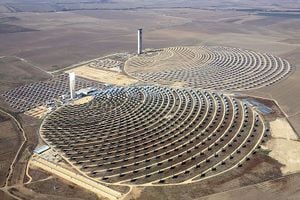
A solar power tower is a type of indirect solar power technology. Solar power is electricity produced from the radiation of the sun. The energy of the sun can be captured and converted into power directly with Photovoltaic solar panels (PV) or indirectly by solar thermal conversion using Concentrated solar power (CSP) technology. [1] CSP technology uses thermal energy from the sun to heat a liquid, such as water or molten salt. This heat transferring liquid is used to vaporize water to the point of steam, which is then used to generate electricity in a traditional turbine-generator. Power plants using CSP technology include parabolic trough, parabolic dish and solar power tower systems. [2]
Background
Energy Collection
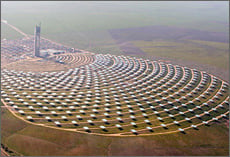
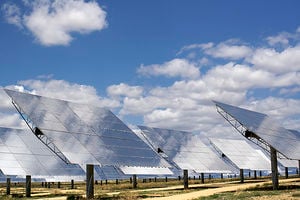
In order to concentrate the solar radiation from a very large area to a much smaller panel, an array of highly reflective heliostats reflect the sunlight to the thermal heat receiver or receivers located on the top of the tower. The arrangement of heliostats may vary between crescent shaped or radial arrays depending on how many receivers there are on a tower and where they are located[3]. In order for the receiver to collect full sun, 1000W/m2, they are programmed to follow the movement of the sun. Another important factor to obtain optimal radiation is to keep the heliostat panels clean and reflective[4].
Energy to Energy Conversion
The thermal heat collected from the receiver can get up to temperatures of about is used to heat molten salt to exceedingly high temperatures of nearly 300°C. This thermal liquid is then circulated through water via pipes which then creates steam. That steam is used to turn turbines in electrical generators to produce the electricity that will then enter the surrounding grid. [1]
Storage
One of the most challenging issues with any form of renewable energy is energy storage. With a solar powered system for example, once the sun goes down you have no more electricity production. However if you have a thermal storage medium such as molten salt, heat can be stored for hours after the sun goes down. At the moment the PS10 solar power tower plant stores heat in tanks as steam, which only gives a storage time of about an hour. Future projects such as the Solar Tres power tower in Andalusia, Spain, are now storing heat in storage tanks of molten salts such as sodium and potassium nitrate. A variety of fluids have been tested for the transport and storage of the sun's heat, including water, air, oil, and sodium, but molten salt was determined the most efficient. Molten salt is usually made up of 60% sodium nitrate and 40% potassium nitrate which may also be referred to as saltpeter. This salt has a melting point of 220 °C or 430 °F and is kept liquid at 290 °C or 550 °F. Molten salt is an ideal material for storage in solar power tower systems because it is efficient and inexpensive. The benefit of having this kind of long term heat storage system is that even with an intermittent renewable energy like solar, you can constantly be providing power to the grid.
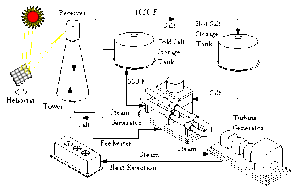
Advantages
- Provides large amounts of electricity daily
- Power can constantly be produced and provided to the grid
- Clean energy for commercial use
Disadvantages
- Takes up a lot of land
- Solar technology is still very expensive
- Daily Maintenance
Previous Projects
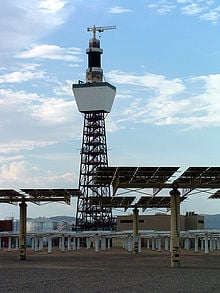
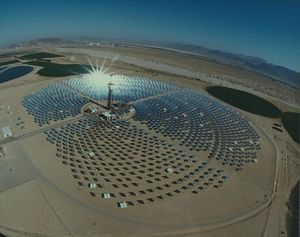
Solar One
The first CSP tower plant was the Solar One with a power capacity of 10MW.[1] The plant was located in the Mojave Desert, California near the town of Barstow.[1] The purpose of this solar power project was to show the potential of a large scale solar power tower plant. Solar one successfully produced over 38 million KWh of electricity in the 6 years it was operational in 1982-1988.[5]
Solar Two
After Solar One ceased operation, in 1995 the plant was renovated and reopened utilizing new technology to increase the efficiency of its storage system[6]. Thus the Solar Two was born. The Solar Two plant utilized a molten-salt energy storage system that is still used for current solar power tower projects[7]. The Solar One and Two demonstration plants were very successful in encouraging countries all over the world to pursue and improve the technology of solar power tower plants.
Current Projects
Planta Solar 10
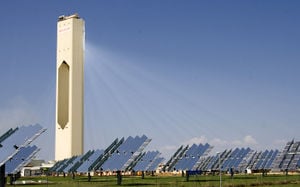
Planta Solar 10 is the first CSP system producing grid-connected power for commercial use. The PS10 was completed in 2008 and manufactured by Abengoa. The system uses 624- 120m2 glass metal heliostats over a 75,000m2 with a net turbine capacity of 11MW. With this 11MW, the PS10 is able to generate enough energy to power about 5,500 Spanish households a day.[1]
Planta Solar 20
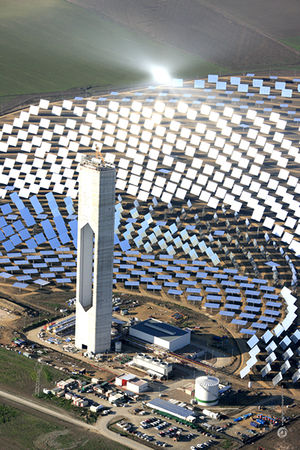
Planta Solar 20 is the sister plant to the PS10 with technological advancements. This system utilizes a more efficient solar receiver on the tower and molten salt storage. The PS20 has a power capacity of 20MW and is able to power over 10,000 Spanish households a day. The field holds 1,255 heliostats, each with a surface area of 120m2, the same as the PS10. [1]
Sierra SunTower
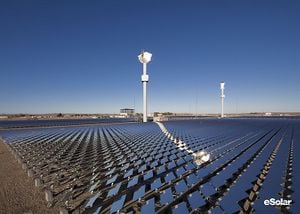
The Sierra SunTower project is a solar power tower operating in Lancaster, CA. This is the only operating plant in North America and occupies around 20 acres or 80,000m2 in the Mojave Desert [8] . This system consists of 24,360- 1.136m2 heliostats, giving a net power capacity of 5.0 MW [9]. Sierra was completed in 2009 by eSolar and is selling their electricity to Southern California Edison. [10]
Future Projects
Gemasolar
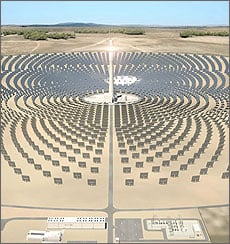
This 17MW plant is located in Andalucia, Seville, Spain. It has a slightly different design from the PS10 and PS20 in that its a central tower and it utilizes a molten salt storage system. The 500°C storage tank provides 15 hours of electricity generation without sunlight. This plant has 2,500 heliostats on an area of 1.85km2. When finished, this system will produce 110GWh/year to power over 25,000 Spanish homes. The Gemasolar has under construction currently and should be done by the end of 2010.
Solar Tres
The Solar Tres is a also a project of Abengoa in southern Spain. This project has recently received a subsidy of five million Euros from the European Commission. The design is similar to the Solar Two plant in using molten salt storage technology but will be three times the size of the Solar two producing 6,000MWh a day. There is a field of 2,500 glass-metal heliostats at 96m2 each. The molten salt storage tank has a capacity of 6,250 T creating 16 hours of extra energy generation.
Further Reading
Miyares, Dave. "Concentrated Solar Power Projects Receive $62 million From DOE". Solar Power Engineering. June 12, 2010 [11]
U.S. Department of Energy: Energy Efficiency and Renewable Energy News [12]
References
- ↑ 1.0 1.1 1.2 1.3 1.4 1.5 Robles, Pedro. "PS20 Tower". Abengoa Solar. June 12, 2010. [1]
- ↑ Richter, Dr. Cristoph. "CSP- Technology". SolarPACES. June 12, 2010. [2]
- ↑ Arvizu, Dan. "Concentrating Solar Power". National Renewable Energy Laboratory. June 12, 2010 [3]
- ↑ Arvizu, Dan. "Concentrating Solar Power". National Renewable Energy Laboratory. June 12, 2010 [4]
- ↑ U.S. DOE. "Solar Power Towers Deliver Energy Solutions." Waste Isolation Pilot Plant. June 12, 2010. [5]
- ↑ U.S. DOE. "Solar Power Towers Deliver Energy Solutions." Waste Isolation Pilot Plant. June 12, 2010. [6]
- ↑ U.S. DOE. "Solar Power Towers Deliver Energy Solutions." Waste Isolation Pilot Plant. June 12, 2010. [7]
- ↑ Arvizu, Dan. "Concentrating Solar Power Projects". National Renewable Energy Laboratory. June 12, 2010 [8]
- ↑ Arvizu, Dan. "Concentrating Solar Power Projects". National Renewable Energy Laboratory. June 12, 2010 [9]
- ↑ Arvizu, Dan. "Concentrating Solar Power Projects". National Renewable Energy Laboratory. June 12, 2010 [10]